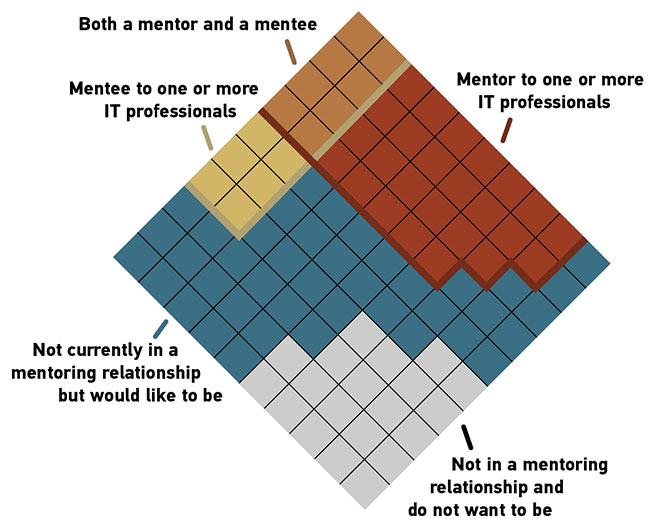Overall State of Mentoring: High Need, but Few Receiving Mentoring
What if you were throwing a party that everyone was excited about but no one knew when and where it was taking place? Or worse yet, people arrived and there actually wasn't a party? Mentoring is not necessarily a party, but enthusiasm for being in a mentoring relationship doesn't guarantee it will occur. Even formal mentoring program goals may not always translate into robust mentoring relationships or an institutional culture of mentoring.1 With this in mind, we asked higher education IT employees what they are actually doing in terms of mentoring relationships and goals (figure 2).

Overall, 39% of higher education IT professionals were either protégés or mentors. Only 14% reported they were currently protégés, and a third (33%) were mentoring one or more IT professionals. Few (8%) served as both mentors and protégés. Higher education IT professionals want to engage in a mentoring relationship, and there is a strong need among the workforce to both learn from more seasoned employees and share their own expertise. Forty-one percent were not in a mentoring relationship but would like to be; 20% were not in a mentoring position and would not like to be.
This year's workforce landscape report found that although women continue to increase their numbers in the higher education IT workforce, it remains a male-majority workforce.2 Despite this gender imbalance, men and women are involved in a mentoring relationship at similar rates. Comparable percentages of men (34%) and women (31%) were mentors, and comparable percentages of men (13%) and women (15%) were protégés. Among those who were not in a mentoring relationship but wanted to be, 42% were men and 40% were women. Finally, only slightly fewer men (18%) than women (23%) were not in a mentoring relationship and did not want to be.
Our findings across organizational levels reflect a workforce that is hungry to be mentored. This is good news for those who wish to mentor, as it suggests a large pool of potential protégé candidates, but not so great news for those staff seeking to be mentored; for many, this simply has not happened yet. We found significant differences between professional seniority for being a mentor and the desire to be in a mentoring position. More CIOs (56%) and managers (40%) reported being mentors than staff (15%). About half of staff (49%) told us they were not currently in a mentoring relationship but would like to be, compared with managers (36%) and CIOs (31%). Managers should seriously consider that staff crave mentoring relationships and seek to link their employees with mentoring opportunities. CIOs and managers are engaging as mentors more than staff, so this suggests that experienced mentors at management levels are available for mentoring. This also suggests that there are opportunities for staff to engage in peer mentoring or group mentoring with CIOs and managers.
Differences between generations were also found, suggesting that age of higher education IT employees may be an important factor when it comes to understanding mentoring relationships (noting that older generations tend to occupy more of the higher-ranking positions). Millennials, Generation Xers, and Baby Boomers3 differed significantly in terms of their mentoring activities. More Millennials (51%) than Gen Xers (43%) and Baby Boomers (35%) were not in a mentoring relationship but wanted to be. In light of our findings, mentoring Millennials should be seen as a priority for IT managers and CIOs. Given the low numbers of Millennials in the higher education IT workforce (compared with the general US workforce),4 mentoring should be viewed as an important means to attract and retain Millennial talent.5 However, our results suggest that we can't focus solely on mentoring younger IT employees. Even seasoned employees see benefits and learning opportunities as they continue to grow their careers.6
Millennial employees expect their supervisors to provide career guidance, feedback, mentorship, and sponsorship to help them thrive in the workplace.7 With a formal mentoring program opportunity, younger employees are able to have their career goals addressed, gain industry knowledge, increase leadership and technical skills, and develop the ability to creatively foster innovation. Formal mentorship can provide structure and a clear path toward identifying and achieving goals while demonstrating the organization's investment in the success of this generation of employees.
Notes
-
See, for example, challenges in formal mentoring program participation here: Amanda Schnieders, "Why Workplace Mentoring Programs Fail," Entrepreneur, June 25, 2018.
↩︎ -
Galanek, Gierdowski, and Brooks, The Higher Education IT Workforce.
↩︎ -
In 2019, we continue the practice of drawing up generational definitions as delineated by the Pew Research Center. The definitions used in this report are as follows: Millennials (born 1981–1997), Gen Xers (born 1965–1980), and Baby Boomers (born 1946–1964). For more information, see Pew Research Center, "The Generations Defined," May 8, 2015.
↩︎ -
Galanek, Gierdowski, and Brooks, The Higher Education IT Workforce.
↩︎ -
See "The 2016 Deloitte Millennial Survey: Winning Over the Next Generation of Leaders."
↩︎ -
See, for example, Judith Lindenberger and Marian Stoltz-Loike, "Mentoring and Baby Boomers," The Balance Careers, December 16, 2018.
↩︎ -
Jeanne C. Meister and Karie Willyerd, "Mentoring Millennials," Harvard Business Review, May 2010.
↩︎